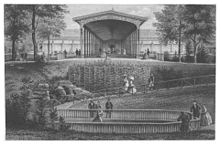Elisabethenbrunnen
The Elisabethenbrunnen is one of the most famous fountains in the spa town of Bad Homburg vor der Höhe . It contains a spring that was rediscovered as a healing spring by the doctor Eduard Christian Trapp in 1834 . Already Isaac Sinclair mentioned the source in a 1799 published book on the salt production in Homburg. Interest in medicinally usable sources was awakened at the latest after the Ludwigsbrunnen was opened in Homburg in 1809. Trapp had the spring grasped and convinced Landgrave Ludwig to commission Justus von Liebig to analyze the water . The appraisal cost 400 guilders and resulted in the positive:
"It would probably be difficult in Germany to find a mineral water that could offer the same wealth of effective ingredients as the Homburg mineral water."
The source and fountain are named after Princess Elisabeth , the wife of Landgrave Friedrich VI. von Hessen-Homburg and daughter of the British King Georg III.
The fountain has been redesigned several times. It was given its current shape with a round temple and marble sculpture of the Greek goddess Hygieia in 1918 under Kaiser Wilhelm II by the sculptor Hans Dammann . The cost of 100,000 marks was donated by a Krefeld spa guest.
For the public there is a simply designed tap in the immediate vicinity of the street - on the edge of the spa gardens.
The water in the fountain is a sodium chloride acid. The water temperature is 10.5 degrees. It was used to treat stomach and intestinal diseases.
See also
swell
- State Office for Monument Preservation Hessen (Ed.): Elisabethenbrunnen In: DenkXweb, online edition of cultural monuments in Hessen
- Gerta Walsh: A water like no other. In: Taunus-Zeitung of July 23, 2012, p. 12. ( online )
Web links
Coordinates: 50 ° 13 ′ 34.5 " N , 8 ° 37 ′ 45.44" E


